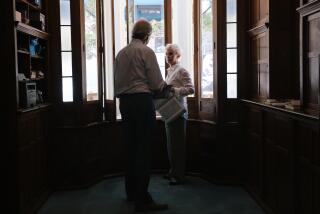Restoring Hidden History Under the Mission’s Dome
- Share via
SAN JUAN CAPISTRANO — The original painted decorations inside the dome of the Great Stone Church at Mission San Juan Capistrano, seen by few people since an 1812 earthquake heavily damaged the church, are finally being studied and preserved.
Mission officials have taken samples of the paint from the 13 depictions of fruit, vegetables and other designs to the University of Pennsylvania for analysis. They plan to treat the artworks with chemicals to bring out their colors and preserve them.
The paintings, believed to have been done from 1806 to the time the massive quake rocked the church, were covered with dirt and fungus until rediscovered about 10 years ago. The quake killed 38 adults and two children at the church.
But the art had not been closely examined until now. Efforts to restore the west wall of the crumbling four-story church allowed preservationists to reach the 42-foot-high paintings.
“We knew paintings were there, but like the Sistine Chapel we couldn’t see them very well because they were [so high] and were covered in dirt and dust,” said Jerry Miller, mission administrator. “We will need to use chemicals to bring out some of the colors.”
Since the $7-million church restoration project began three years ago, mission officials have raised $1.8 million for repairs to keep the Great Stone Church from toppling. Another $3 million was raised to retrofit other structures at the 221-year-old mission.
The paintings include a rosette-shaped design outlined in black paint in the center of the dome and pineapple- and artichoke-shaped illustrations in the center stone of the main archway to the dome and in nooks around the dome.
Since its collapse in 1812, most of the interior walls of the church have been exposed to rain and light. The designs have remained intact because they were beneath the dome.
“There used to be more decoration in other parts of the church,” said Elisa Del Bono, site conservator. “But the reason why these are still visible is because it’s the only area where we have a roof and the roof is in good condition.”
The mission was the largest stone church in the United States at the time it was built. Of all the missions founded by Father Junipero Serra, San Juan is the most popular among tourists.
Conservationists are unsure whether the designs were the work of Juaneno Indians or the Spanish.
“Whoever it was had a natural talent and knew what they were doing,” said John Loomis of Thirtieth Street Architects in Newport Beach.
Loomis is the project manager of the mission’s conservation project.
“You could see some of the decorations from below, but not until most recently when we installed the scaffolding could you see it and touch it. . . . It is an amazing find.”
Crouched on a platform 42 feet above the ground, Del Bono studies a design in the center of the main archway that is molded with cement.
Del Bono is one of two preservationists hired by the mission to repair crumbling walls and archways.
Several teams of students from the University of Pennsylvania have been repairing the church for two years under the direction of Frank Matero of the university.
Paint expert Rynta Fourie has taken samples of the paint to the university lab to determine what pigments and binders were used so that the process can be used in future restoration treatments.
Fourie believes the Indian or Spanish artists used eight colors and two techniques, secco and fresco. Secco is paint technique that is applied to dry plaster; fresco-style painting is applied to wet plaster.
According to Del Bono, an exhibit showing facsimiles of the designs may be built on the ground so visitors can get a close-up look at what’s high on the dome.
“Once the scaffolding is gone, it will be difficult to appreciate them from the ground,” she said.
More to Read
Sign up for Essential California
The most important California stories and recommendations in your inbox every morning.
You may occasionally receive promotional content from the Los Angeles Times.










